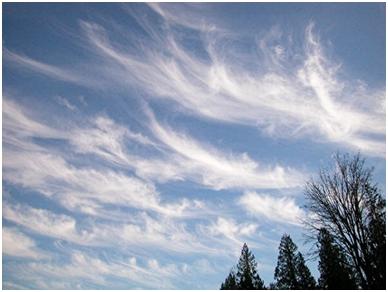The Water Cycle + Clouds

Water is present in the atmosphere in solid, liquid, and vapor states. On the surface of the Earth, water is essential in both chemical and physical weathering processes. Before it is the water, we see if undergoes different processes daily. This quiz will help test your knowledge of the Water Cycle and a few different types of clouds.
- 1.
What is another name for precipitation?
- A.
Clouds
- B.
Sunlight
- C.
Rain
- D.
Ocean
- E.
Fire
Correct Answer
C. RainExplanation
Precipitation refers to any form of water that falls from the atmosphere to the Earth's surface. This can include rain, snow, sleet, or hail. In this case, the correct answer is "Rain" as it is a specific type of precipitation that occurs when water droplets in the atmosphere become too heavy and fall to the ground.Rate this question:
-
- 2.
Condensation occurs when...
- A.
Rain falls on lakes and rivers.
- B.
Vapor in the air cools and changes back into liquid to form clouds
- C.
Clouds appear
- D.
Rain forms clouds
Correct Answer
B. Vapor in the air cools and changes back into liquid to form cloudsExplanation
Condensation occurs when vapor in the air cools and changes back into liquid to form clouds. This process happens when warm air rises and cools down, causing the water vapor to lose heat and transform into tiny water droplets. These droplets then come together to form clouds. This is a natural phenomenon that is crucial for the water cycle and the formation of precipitation such as rain.Rate this question:
-
- 3.
When clouds get heavy what happens next?
- A.
It rains
- B.
It gets windy
- C.
Clouds fall to earth
- D.
Rivers and lakes overflow
Correct Answer
A. It rainsExplanation
When clouds get heavy, it rains. This is because the heavy clouds contain a significant amount of water vapor that condenses into liquid droplets due to cooling temperatures and atmospheric conditions. These droplets then become too heavy to remain suspended in the air, leading to precipitation in the form of rain.Rate this question:
-
- 4.
What are the main features of the water cycle?
- A.
Precipitation, evaporation
- B.
Precipitation, ovulation, condensation
- C.
Condensation, evaporation, respiration
- D.
Ovulation, respiration, condensation
- E.
Evaporation, precipitation, condensation
Correct Answer
E. Evaporation, precipitation, condensationExplanation
The water cycle is the continuous movement of water on, above, and below the surface of the Earth. Evaporation is the process by which water changes from a liquid to a gas, usually from the surface of the Earth into the atmosphere. Precipitation is the process by which water falls from the atmosphere to the Earth's surface in the form of rain, snow, sleet, or hail. Condensation is the process by which water vapor in the air cools and changes back into liquid form, forming clouds. Therefore, the correct answer is evaporation, precipitation, condensation.Rate this question:
-
- 5.
What causes water to evaporate?
- A.
Fire
- B.
Clouds
- C.
Sunlight
- D.
Fog
Correct Answer
C. SunlightExplanation
Sunlight causes water to evaporate because it provides energy in the form of heat. When sunlight shines on water, the water molecules gain energy and become more active. This increased energy causes the water molecules to break free from the liquid and turn into water vapor, which is the process of evaporation. Therefore, sunlight is the main factor that drives the evaporation of water.Rate this question:
-
- 6.
What type of cloud is this?
- A.
Cumulus
- B.
Nimbus
- C.
Stratus
- D.
Cirrus
Correct Answer
C. StratusExplanation
The given cloud is most likely a stratus cloud. Stratus clouds are low-level clouds that appear as a uniform, gray layer covering the sky. They are often flat and featureless, with a smooth appearance. This type of cloud is associated with stable weather conditions and can bring light precipitation or drizzle. Cumulus clouds are puffy and have a vertical development, Nimbus clouds are associated with precipitation and storms, and Cirrus clouds are high-level clouds that are thin and wispy in appearance. Therefore, based on the description provided, the correct answer is Stratus.Rate this question:
-
- 7.
What type of cloud is this?
- A.
Nimbus
- B.
Cumulus
- C.
Cirrus
- D.
Stratus
Correct Answer
B. CumulusExplanation
A cumulus cloud is a type of cloud that is characterized by its fluffy, white appearance and flat base. It is typically found at lower altitudes and indicates fair weather conditions. The cloud in question is likely a cumulus cloud because it appears to have a rounded shape and a distinct, puffy texture.Rate this question:
-
- 8.
What Type of cloud is this?
- A.
Cirrus
- B.
Stratus
- C.
Nimbus
- D.
Culumbus
Correct Answer
A. CirrusExplanation
The correct answer is Cirrus. Cirrus clouds are high-level clouds that appear thin, wispy, and feathery. They are composed of ice crystals and are usually found at high altitudes. Cirrus clouds are often associated with fair weather, but they can also indicate the approach of a warm front. Their appearance is characterized by their fibrous or curly nature, and they are commonly seen in the form of streaks or patches in the sky.Rate this question:
-
Quiz Review Timeline +
Our quizzes are rigorously reviewed, monitored and continuously updated by our expert board to maintain accuracy, relevance, and timeliness.
-
Current Version
-
Mar 21, 2023Quiz Edited by
ProProfs Editorial Team -
Feb 19, 2010Quiz Created by
Georgia.m




